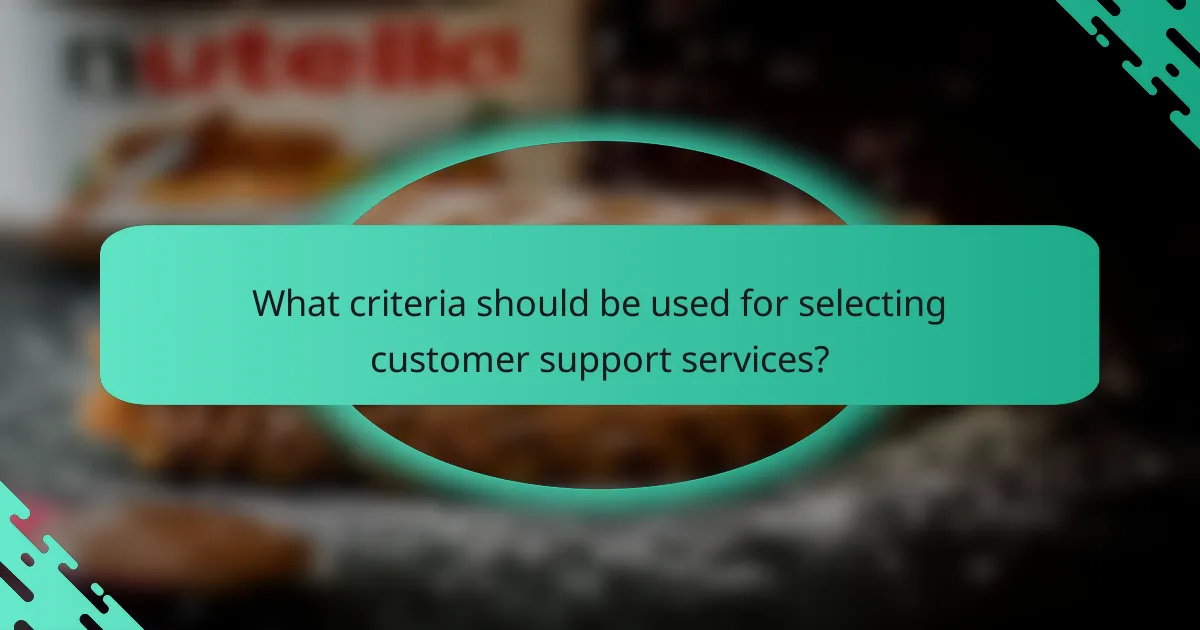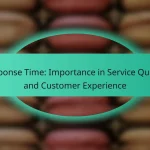Choosing the right customer support options is essential for enhancing customer satisfaction and retention. By evaluating factors such as response time, availability, and customer satisfaction ratings, businesses can identify the most effective support channels, including live chat, phone, email, social media, and in-person assistance. Each option offers distinct benefits tailored to meet diverse customer needs, ultimately fostering stronger relationships and driving growth.

What are the best customer support options in Los Angeles?
The best customer support options in Los Angeles include live chat, phone, email, social media, and in-person support. Each option offers unique benefits and features that cater to different customer needs and preferences.
Live chat support
Live chat support provides real-time assistance through a website or app, allowing customers to communicate instantly with support agents. This option is often preferred for its convenience and speed, typically resolving issues in a matter of minutes.
When implementing live chat, ensure that agents are well-trained and available during peak hours. Consider using chatbots for initial inquiries to enhance efficiency and reduce wait times.
Phone support
Phone support remains a popular choice for customers who prefer direct communication. It allows for detailed discussions and immediate feedback, which can be crucial for complex issues.
To optimize phone support, maintain a well-organized call center with knowledgeable staff. Aim for low wait times, ideally under five minutes, and ensure that representatives can handle a wide range of inquiries.
Email support
Email support is effective for non-urgent issues, allowing customers to provide detailed information at their convenience. It is suitable for inquiries that require documentation or lengthy explanations.
Set clear expectations for response times, ideally within 24 hours. Use templates for common questions to streamline responses while maintaining a personal touch.
Social media support
Social media support leverages platforms like Twitter and Facebook to engage with customers. This method is particularly effective for brand visibility and quick responses to public inquiries.
Monitor social media channels regularly and respond promptly to comments and messages. Establish guidelines for tone and content to ensure consistent brand representation.
In-person support
In-person support offers a personal touch, allowing customers to interact face-to-face with representatives. This option is beneficial for complex issues that require hands-on assistance or demonstrations.
Ensure that physical locations are easily accessible and staffed with knowledgeable personnel. Consider offering appointments to manage customer flow and minimize wait times.

How to evaluate customer support options?
Evaluating customer support options involves assessing key factors that impact the quality and effectiveness of service. Focus on response time, availability, and customer satisfaction ratings to make informed decisions.
Response time
Response time refers to how quickly a customer support team addresses inquiries or issues. A shorter response time is generally preferred, with many customers expecting replies within minutes to a few hours, depending on the channel used.
To evaluate response time, consider the average time taken to resolve issues across different support channels, such as email, phone, or live chat. Aim for a service that consistently meets or exceeds industry standards, which often suggest response times in the low tens of minutes for live chat and single-digit hours for email.
Availability
Availability indicates when customer support is accessible to assist users. Look for options that offer 24/7 support, especially if your business operates across multiple time zones or if your customers require assistance outside of regular business hours.
Consider the channels available for support, such as phone, email, or chat, and whether they are staffed at all times. A good practice is to check if the support team provides self-service options, like FAQs or chatbots, which can help customers find answers even when live agents are unavailable.
Customer satisfaction ratings
Customer satisfaction ratings reflect how well a support team meets customer needs and expectations. High ratings often correlate with effective service, so look for metrics such as Net Promoter Score (NPS) or Customer Satisfaction Score (CSAT) to gauge performance.
When evaluating customer satisfaction, read reviews and testimonials to understand common strengths and weaknesses. Aim for support options with ratings consistently above average, ideally in the high seventies to low eighties percentile range, as this indicates a strong likelihood of positive customer experiences.

What are the benefits of effective customer support?
Effective customer support provides numerous advantages, including enhanced customer satisfaction and retention. By addressing customer needs promptly and efficiently, businesses can foster long-lasting relationships and drive growth.
Increased customer loyalty
Increased customer loyalty stems from positive interactions with support teams. When customers feel valued and their issues are resolved quickly, they are more likely to return for future purchases. This loyalty can translate into repeat business and referrals, significantly benefiting the bottom line.
To cultivate loyalty, companies should focus on personalized service and follow-up communications. Simple gestures, such as thanking customers for their feedback or offering loyalty discounts, can reinforce their commitment to customer satisfaction.
Improved brand reputation
Improved brand reputation is a direct result of effective customer support. Satisfied customers often share their experiences through word-of-mouth or online reviews, which can enhance a company’s image. A strong reputation can attract new customers and differentiate a brand in a competitive market.
To maintain a positive reputation, businesses should actively monitor feedback across platforms and address any negative comments promptly. Engaging with customers on social media and showcasing positive testimonials can further bolster brand perception.
Higher sales conversion rates
Higher sales conversion rates can be achieved through effective customer support, as it helps address potential buyer concerns in real-time. When customers receive timely assistance, they are more likely to complete their purchases, leading to increased sales.
Implementing live chat options or responsive email support can significantly improve conversion rates. Additionally, training support staff to provide product knowledge and upselling techniques can further enhance the customer experience and drive sales growth.

What features should you look for in customer support?
When evaluating customer support options, focus on features that enhance accessibility, efficiency, and user satisfaction. Key aspects include multi-channel support, self-service options, and knowledge base access, which collectively improve the overall customer experience.
Multi-channel support
Multi-channel support allows customers to reach out through various platforms such as phone, email, chat, and social media. This flexibility ensures that customers can choose their preferred method of communication, which can lead to higher satisfaction rates.
Consider the integration of these channels. A seamless transition between them can enhance the support experience. For example, if a customer starts a chat and later needs to call, the support agent should have access to the chat history to provide context.
Self-service options
Self-service options empower customers to find solutions independently, reducing the need for direct interaction with support staff. Features like FAQs, troubleshooting guides, and automated chatbots can help customers resolve common issues quickly.
Implementing a user-friendly interface for self-service tools is crucial. Ensure that these resources are easily accessible and organized logically, so customers can find the information they need without frustration.
Knowledge base access
A comprehensive knowledge base is essential for effective customer support. It should contain articles, tutorials, and videos that address common questions and problems. This resource not only aids customers but also reduces the volume of inquiries to support teams.
Regularly updating the knowledge base is vital. Incorporate feedback from customers and support agents to ensure the content remains relevant and useful. Consider using analytics to identify which topics are most searched for and prioritize those in your updates.

What criteria should be used for selecting customer support services?
When selecting customer support services, consider factors such as response time, availability, communication channels, and customer satisfaction ratings. These criteria help ensure that the support team can effectively meet customer needs and enhance overall service quality.
Response Time
Response time is critical in customer support, as it directly impacts customer satisfaction. Aim for a response time of under a few minutes for live chat and phone support, while email responses should ideally be within a few hours. Fast response times can significantly improve customer perceptions of your service.
Availability
Availability refers to the hours during which customer support is accessible. Many businesses opt for 24/7 support to cater to global customers, while others may offer limited hours. Consider your target audience’s needs; if most inquiries come after regular business hours, extended availability may be necessary.
Communication Channels
Different customers prefer different communication channels, such as phone, email, live chat, or social media. Offering multiple channels can enhance accessibility and convenience. Evaluate which channels are most effective for your customer base and ensure that your support team is well-trained in each method.
Customer Satisfaction Ratings
Customer satisfaction ratings provide insights into the effectiveness of your support services. Regularly collect feedback through surveys or reviews to gauge customer experiences. Aim for high satisfaction scores, as they can indicate areas for improvement and help build customer loyalty.


